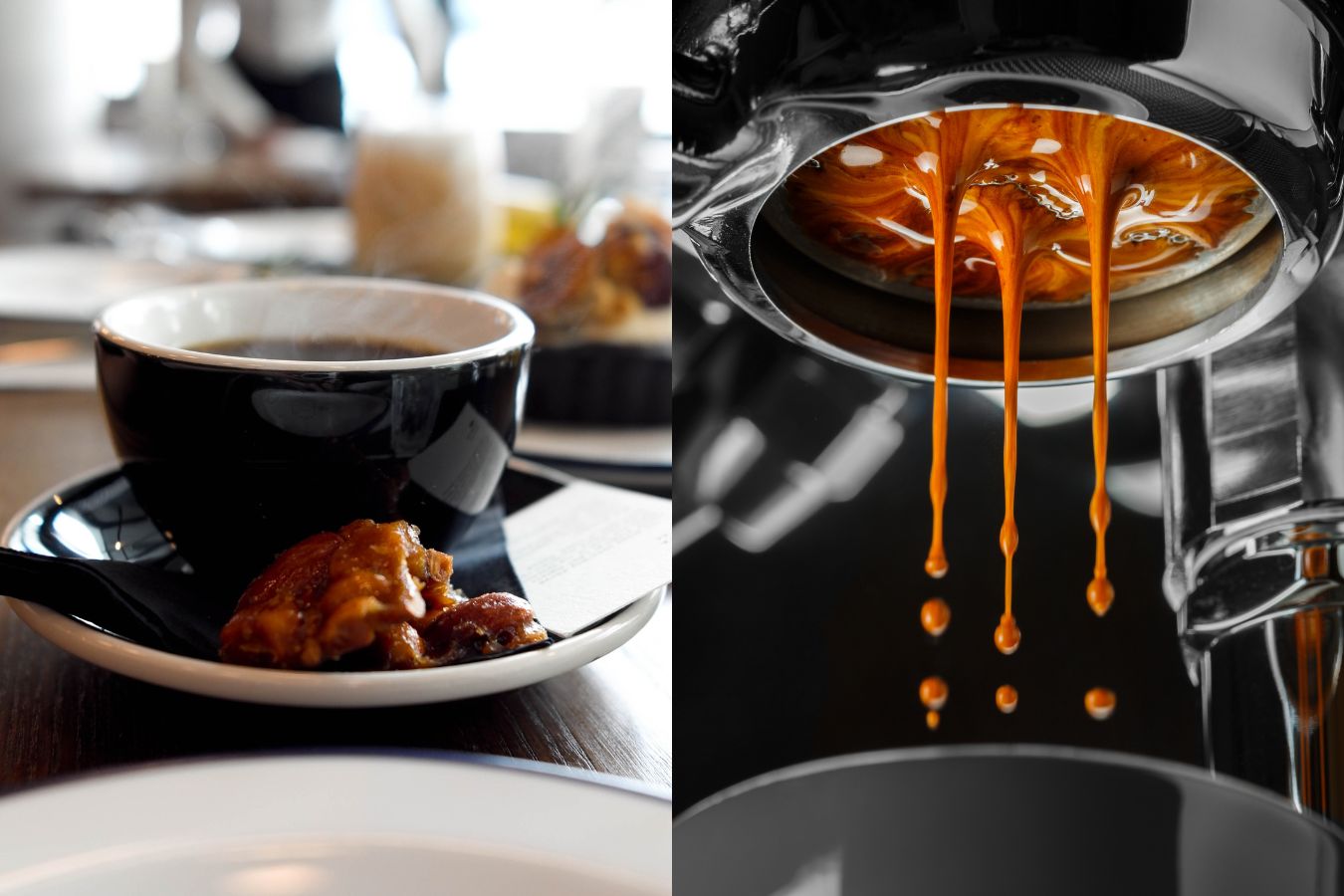Coffee Beans 101: Whatever You Need to Know About Espresso and Blended Coffee Beans
When it concerns coffee, recognizing the nuances of coffee and blended beans can transform your day-to-day cup. You'll find the distinct attributes of Arabica and Robusta beans, and how each effects taste and caffeine material. From the growing procedure to toasting techniques, every step contributes in your coffee experience. What makes the perfect brew? Allow's explore the crucial elements that contribute to a remarkable mug of coffee.
Comprehending Coffee Beans: Kinds and Varieties
When diving right into the globe of coffee, recognizing the kinds and varieties of coffee beans is necessary for every fanatic. You'll mainly come across 2 major varieties: Arabica and Robusta. Arabica beans are known for their smooth, complex tastes and reduced high levels of caffeine content, making them a favorite among coffee enthusiasts. On the other hand, Robusta beans pack a strike with a more powerful, extra bitter preference and higher high levels of caffeine degrees, often used in espresso blends.
Within these species, you'll locate different regional varieties, each bringing unique attributes. Ethiopian Yirgacheffe supplies intense floral notes, while Colombian beans provide a healthy taste account. As you discover, remember to focus on handling techniques like cleaned or all-natural, as they can considerably influence the last taste. By familiarizing on your own with these beans and their tastes, you'll elevate your coffee experience and make more informed selections in your brewing trip.
The Expanding Process: From Seed to Bean
When you explore the journey of coffee, everything begins with seed option strategies that set the structure for quality. From there, growing and collecting play important duties in guaranteeing the beans flourish. Processing techniques change those gathered cherries right into the coffee beans you like.
Seed Choice Techniques
Choosing the appropriate seeds is necessary for producing top notch coffee beans, as it lays the foundation for the entire growing procedure. You need to start by selecting seeds from trusted resources that focus on quality and genetic diversity. Try to find varieties understood to grow in your particular environment and soil problems. Pay interest to the seed's age and storage conditions, as fresh seeds have a tendency to sprout better. When possible, select natural seeds to minimize exposure to unsafe chemicals. Consider the disease resistance of different ranges, as this can greatly impact your yield. Lastly, do not hesitate to talk to neighborhood farmers or specialists to acquire understandings right into the finest seed choices for your area. This expertise will certainly improve your coffee-growing experience.
Cultivation and Harvesting
As you support your coffee seeds right into prospering plants, comprehending the farming and harvesting procedure is important for attaining the very best taste and quality. Beginning by growing your seeds in well-draining dirt, ideally in a shaded location to shield them from straight sunshine. As your plants grow, keep regular wetness, and bear in mind their demand for nutrients. Trim routinely to promote airflow and healthy and balanced development.
Hand-picking is commonly the best technique to assure only the ripest cherries are picked. Timing is vital; collecting as well late or as well very early can influence the taste profile of your beans.

Processing Techniques Explained
Once you have actually gathered your coffee cherries, the next necessary action is processing them to change those vivid fruits right into the beans you'll brew. There are 2 primary techniques: the completely dry process and the damp procedure. In the completely dry procedure, you spread out the cherries out in the sunlight to completely dry, allowing the fruit to ferment and give distinct flavors to the beans. On the other hand, the wet process entails removing the fruit promptly and fermenting the beans in water, resulting in a cleaner taste. After processing, the beans are hulled, sorted, and generally dried out once more. Each approach influences the flavor profile, so trying out both can help you discover your preferred brew. Comprehending these techniques is key to enjoying your coffee experience.
Toasting Strategies: Exactly How Flavor Is Developed
When it comes to toasting coffee beans, comprehending roast levels is essential to revealing their unique tastes. Each roasting technique influences the scent and improves the flavor growth process, offering you a richer coffee experience. Let's discover exactly how these elements come with each other to raise your daily mixture.
Roast Levels Explained
Roast degrees play a crucial duty fit the flavor account of your coffee. When you select a light roast, you'll delight in bright level of acidity and fruity notes. As you transfer to a tool roast, you'll observe an equilibrium of sweetness and intricacy, often highlighting chocolate or caramel tastes. Dark roasts, on the various other hand, provide bold, smoky characteristics with much less level of acidity, making them durable and rich. Each degree arises from different roasting times and temperature levels, affecting the beans' chemical composition. By recognizing these levels, you can better pick a coffee that matches your preference preferences. Explore various roasts to discover which one reverberates with you, enhancing your general coffee experience and satisfaction.
Influence on Aroma
The roast degree not only influences the preference of your coffee however likewise significantly affects its scent. Each toasting technique launches different unstable compounds, forming exactly how your coffee smells. Additionally, the quality of the beans plays a critical duty; newly roasted coffee releases more aromatic oils, boosting that luring scent.
Flavor Development Refine
As you discover the flavor growth procedure, you'll uncover that toasting methods play a vital role in forming the preference profile of your coffee. The toasting temperature level and time straight affect the acidity, sweet taste, and anger of the beans. Light roasts keep even more of the bean's initial flavors, highlighting floral and fruity notes.
Espresso vs. Blended Coffee: Secret Distinctions
Coffee and blended coffee each offer special experiences that deal with various tastes and preferences. Espresso is a concentrated coffee made forcibly hot water via finely-ground coffee beans, causing a rich, strong flavor and a velvety layer of crema ahead. It's usually delighted in as a shot or made use of try here as a base for drinks like cappucinos and coffees.
On the various other hand, combined coffee integrates different beans from various regions, producing a much more balanced flavor profile. You'll frequently discover blends that highlight sweet taste, acidity, or body, making them flexible for various brewing methods. While espresso concentrates on strength, mixed coffee may provide a broader series of flavors that can transform with each sip.
Inevitably, your option between espresso and blended coffee boils down to your individual choice. Whether you long for a leisurely cup or a quick shock, both choices have something tasty to offer.

Brewing Approaches: Unlocking the Perfect Cup
When it involves developing coffee, discovering the right approach can transform your experience and raise your mug. Each brewing method has its unique appeal and can significantly influence your coffee's flavor and fragrance. Utilizing a French press permits you to enjoy a robust and abundant mixture, while a pour-over method provides a clean, brilliant mug with distinct tastes.
If you favor coffee, investing in a quality maker can assist you understand the art of pulling shots. look what i found For comfort, a single-serve husk system offers speed without sacrificing taste.
Do not forget chilly brew, which provides a smooth, much less acidic coffee perfect for hot days. Try out various techniques to find what reverberates with your taste buds. Each brewing method opens a brand-new globe of opportunities, so put in the time to discover and find your best cup. Pleased brewing!
Sampling Notes: Recognizing Taste Profiles
Exactly how can you really appreciate your coffee if you do not understand what flavors to look for? Sampling notes are your overview to comprehending the complex globe of coffee. When you drink, focus on the initial tastes that hit your palate. You might identify fruity notes, like berry or citrus, or maybe a nutty undertone. As you proceed to taste, observe how the tastes develop-- this is called the "coating." Some coffees might leave a chocolatey or sugar aftertaste, while others might have a brilliant, clean finish.
Think about the body of the coffee, also; is it light and ventilated or thick and syrupy? Do not forget level of acidity; a bright level of acidity can add vitality, while a reduced acidity could give a smoother experience. By recognizing these flavor accounts, you'll grow your connection with each cup, making coffee sampling a delightful journey of exploration.

Tips for Picking and Storage Coffee Beans
Selecting and keeping coffee beans correctly can greatly improve your brewing experience. Begin by picking premium beans that match your preference. Look for freshness; beans roasted within the last 2 weeks are excellent. Check the roast date on the packaging, and purchase from trusted roasters or regional stores.
When you have your beans, store them in an impermeable container to protect against exposure to light, dampness, and air. A dark, cool location functions best, so prevent keeping them in the refrigerator or freezer, as this can introduce dampness. Just grind the quantity you require to preserve freshness; entire beans preserve taste longer than pre-ground coffee.
Last but not least, attempt to use your beans within two to 4 weeks after opening up for peak taste. Complying with these suggestions will guarantee your coffee remains satisfying and delicious, raising your day-to-day mixture to brand-new heights.
Frequently Asked Inquiries
Just How Long Do Coffee Beans Stay Fresh After Toasting?
Coffee beans stay fresh for about 2 weeks after toasting - SOE. You must store them in an airtight container, away from light and dampness. Afterwards, their flavor and aroma start to diminish considerably

Can I Mix Different Coffee Bean Varieties?
Definitely, you can blend various coffee bean ranges! Explore blends can boost tastes and create an unique preference profile. Just make sure to stabilize the toughness and characteristics of each selection for the ideal results.
What Is the Suitable Grind Dimension for Coffee?
For espresso, find more info you'll desire a fine work dimension, regarding the appearance of salt. This permits excellent extraction, causing a rich, delicious shot. Experiment a little bit to discover what matches your taste best!
Exactly How Does Elevation Affect Coffee Bean Flavor?
Elevation affects coffee bean taste by affecting the growth rate and chemical structure. Higher altitudes lead to slower maturation, which boosts acidity and complexity, providing your coffee a vibrant and special preference you won't fail to remember.
Exist Decaffeinated Variations of Espresso Beans?
Yes, there are decaffeinated variations of espresso beans. You can delight in an abundant espresso taste without the caffeine kick. Just look for "decaf" blends at your neighborhood coffee store or specialty store.
Coffee Beans 101: Whatever You Need to Know About Coffee and Blended Coffee Beans.
When diving into the globe of coffee, recognizing the kinds and selections of coffee beans is crucial for every lover.When it comes to toasting coffee beans, recognizing roast levels is essential to exposing their distinct flavors. Coffee is a concentrated coffee brewed by forcing hot water with finely-ground coffee beans, resulting in an abundant, vibrant taste and a creamy layer of crema on top.On the other hand, blended coffee integrates different beans from various regions, developing a more well balanced taste profile.
Comments on “How SOE Single Origin Espresso Enhances Your Daily Coffee Ritual”